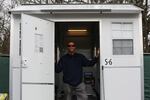Ty Charnicky gripped a broom and smiled as he swept the floor. It wasn’t dirty. He swept it often.
“When I was in the car, I did this to the car too. I cleaned it out at least once a week. I did my laundry once a week,” Charnicky said, before straightening some of his belongings on a nearby table. “You know, I’m still living!”

Ty Charnicky stands in the Pallet Shelter he moved into two weeks prior. Charnicky lauded the shelter, yet stressed the importance of having on-site supportive services.
Troy Brynelson / OPB
It was Charnicky’s second week living in a metal, 8-by-8-foot cabin purchased by the city of Vancouver. He kept it tidy. He was enjoying a “homeostasis improvement” over the recent months he’d spent sleeping in his car.
“It’s about where am I going to be warm tonight? Where am I going to be safe tonight? Where am I going to sleep and no one is going to tell me ‘Move your car?’” he said.
Charnicky’s cabin — and 19 others that line the Vancouver cul de sac — are a product from the Everett, Washington, company Pallet. Lately, the compact dwellings are becoming a common sight in cities looking to build new forms of shelter for their homeless populations.
Pallet has boomed in the pandemic. According to CEO Amy King, sales figures jumped from $250,000 in 2019 to $10 million in 2020. Today, the shelters are in more than 70 communities, up from just three in 2019.
“I guess we were lucky to enter this market when we didn’t really have any competitors that had the volume or scale that we did,” King said.
An idea from the workers
King founded Pallet with her husband in 2016. The couple had run a homebuilding company in Seattle for two decades. King said employees sometimes shared personal stories about experiencing homelessness.
“We were hiring individuals that were exiting the criminal justice system and we started to just really get to know them, learn their stories, hear their struggles of re-entry,” she said. “And so we started to really explore that space and how we could be more helpful.”
Sales of the shelters didn’t take off immediately, however. King recalled cities and counties, to whom she hoped to sell the shelters, needed convincing that the dwellings could accomplish something that traditional shelters couldn’t.
Then, the pandemic started, and cities rapidly tried to figure out how to keep people out of close-quarters shelters.
“A lot of cities that we had been talking to for an extended period of time, trying to convince them of this model, they immediately needed us,” King said. “It was sort of forced on them to embrace something different.”
The shelters are white, framed out of aluminum and insulated with fiberglass. The hard yet glossy exterior is reminiscent of an RV’s outer shell.
For residents, the important features are obvious: the inside is dry, there is at least one bed, it’s wired with electricity and it’s outfitted with heating and air conditioning.
With pieces built, Pallet ships each dwelling to the customer to be assembled on location.
Those locations are all around the United States now. Pallet has built in Dallas, Boston, the Bay Area and the island of Maui.
Early signs of effectiveness
In Tacoma, the first city to do business with Pallet, city staff are bullish. They own 58 of the shelters, through which about 570 individuals have passed. City staff estimate 20-30% of people move into housing after staying in a Pallet shelter.
“That’s pretty high compared to other, more conventional congregate shelters,” said Matt Jorgensen, who oversees Tacoma’s shelter programs.
Jorgensen said Tacoma initially expected its contract with Pallet would last three years. It’s now year five.
“As our city leadership saw the success of folks getting stabilized and moved into housing, they saw it as more of an asset to maintain, (to) keep that in the community as a resource for folks to get connected and into housing,” he said.

Vancouver's "Safe Stay Community" officially opened Dec. 23. Tenants said they were excited to leave their tents and hopeful for more stability in the city-sanctioned site.
Troy Brynelson / OPB
More recently, the city of Vancouver has spent close to half a million dollars on the shelters. After buying the first 20 to set up the city’s “Safe Stay Community,” it bought enough shelters for two more communities.
Not every community is a success. In March, a fire burned three shelters in Oakland. There were no injuries, and the cause of the fire is still under investigation. But the fire was widely publicized in the local press.
Brandon Bills, a company spokesperson, said the company uses materials rated for fire safety and that shelters are equipped to detect smoke and carbon monoxide. He said the shelters meet local fire codes.
“Thankfully everyone at the site escaped uninjured,” Bills said.
To Charnicky, the Vancouver man staying in one of the shelters, Pallet’s dwellings are only one ingredient to help people in his situation. He said the shelters would not be worth much without on-site specialists to assist with everything from getting food and finding showers to offering support for substance abuse.
“Would I say they’re spending their money wisely?” Charnicky said in an interview. “If there are supportive services … then yes. If they’re just buying them to put people in them, it will not work.
“People in the situation that we’re in, all of us, 20 different situations and circumstances, they need support and need help,” Charnicky continued.
According to King, Pallet requires customers to provide on-site services. She called it the company’s “dignity standard.” She said the contracts are written to allow Pallet to take back its shelters if it doesn’t agree with how a customer is using them.
“This is not supposed to be perpetuating people’s cycles of trauma and poverty,” King said. “It’s supposed to be lifting them out of that space and helping them progress towards permanent housing.”
Beyond shelter
Experts on homelessness say cities can’t rely on building shelter alone. Gregg Colburn, a University of Washington professor and a housing policy analyst, said even well-run shelters can’t fully help a person if there’s no housing to move into.
“I hope it’s not a bridge to nowhere,” Colburn said. “If we build tiny homes or other temporary structures, and in three years people are still living in those temporary structures… what happens now?”
New York City has demonstrated that, Colburn pointed out. The city has capacity to shelter tens of thousands of people any given night. But, Colburn said, that has done little to reduce homelessness.
“They’ve spent billions and billions of dollars on that system over the last 20 or 30 years in New York City,” he said. “So yes, they’re off the street. But now they’ve created a very expensive and less-than-ideal system in which people end up getting warehoused within that system.”
Getting into housing remains the goal, residents of Vancouver’s community said. In the meantime, they are finding work and getting treatment that they might not have had otherwise.

Wesley Roseberry sits on a cart at Evergreen Memorial Gardens. Roseberry has lived in a Pallet Shelter since December and said it helped him land his job.
Troy Brynelson / OPB
Before the community appeared at the cul de sac, Wesley Roseberry lived in one of a dozen tents there. It was impossible to stay dry, he recalled.
“It’s actually outrageous the amount of precipitation a tent would hold. You wouldn’t think so!” Roseberry said with a laugh. “When you’re out in the middle of it, you don’t quite realize the impact it has until you get out of it.”
Roseberry spoke while on break from his job as a groundskeeper at Evergreen Memorial Gardens, a cemetery and funeral company in east Vancouver. It was the first job Roseberry had held in more than three years.
“I feel like I’ve had more opportunity since I’ve moved into this place. I was living in a tent and it’s like, you tell someone you live in a tent and automatically it’s like ‘whoposh,’ this wall comes up,” he said. “And that’s the end of it.”
Roseberry does have complaints about the Pallet shelters. He said he worried his shelter was shifting from recent rains and snow. Unlike Charnicky, he was frustrated by some of the community policies, such as a requirement to hand over the door keys when going off-premises.
But Roseberry said he feels better overall.
“I’ll put it to you like this: Mentally and physically, yes, I am completely, 100% better than I was even two months ago,” he said.
According to Vancouver officials, Roseberry is one of eight residents who have already found work in the last three months. And three have moved into permanent housing.